 |
||
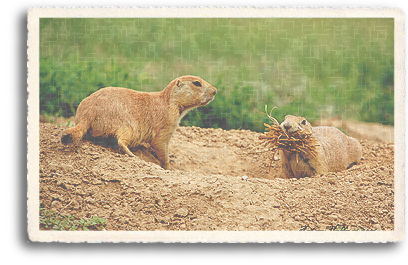 The Prairie Dog The Prairie DogThe Prairie Dog is a small, burrowing rodent (mammal). They are the most social members of the squirrel family and are closely related to ground squirrels, chipmunks and marmots. The Prairie Dog is named for its habitat and warning call, which sounds similar to a dog’s bark. The name goes back to at least 1774, and the journals of the Lewis and Clark expedition note that in September of 1804, they “discovered a village of an animal the French call the Prairie Dog.” The Prairie Dog is found throughout most of the western United States from Canada to Mexico (Montana, the Dakotas, Nebraska, Kansas, Oklahoma, Texas, New Mexico, Colorado, Arizona, Utah, and Wyoming) in short and medium grass prairies and plateaus, sometimes including higher elevations of the Mojave, Great Basin and Chihuahuan deserts. As a general rule, in the United States, Prairie Dogs are primarily found west of the Mississippi River, although they have been introduced in a few eastern locales. 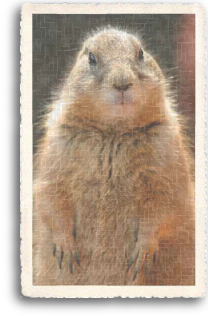 There are five species of Prairie Dogs (genus Cynomys): There are five species of Prairie Dogs (genus Cynomys):• The Black-tailed Prairie Dog is found in the Great Plains of North America from about the US-Canada border to the US-Mexico border. • The White-tailed Prairie Dog inhabits the Western United States in Colorado, Utah, Wyoming, and Montana. • The Gunnison’s Prairie Dog has a much shorter tail than other Prairie Dogs, is uniquely colored, and is found around the Four Corners area of the American Southwest from 5,000-11,000 feet. • The Mexican Prairie Dog is an endangered species with a limited distribution only within parts of Mexico. • The Utah Prairie Dog is the smallest of all Prairie Dogs and is definitely a threatened species. Of the two main species of Prairie Dogs, the Black-tailed Prairie Dog has a black-tipped tail and is much more widespread, occurring sparsely over the Great Plains and throughout the Great Basin. Unlike some others, these animals do not truly hibernate, and therefore the Black-tailed Prairie Dog can be seen above ground in midwinter. These are the type of Prairie Dogs that were normally sold in pet shops, and may either be a baby caught in the wild or from a breeder. The other main species, the White-tailed Prairie Dog, has a white-tipped tail and inhabits higher altitudes than his black-tailed brother. It hibernates in winter and is less colonial in habit. Prairie Dogs are robust rodents, slightly grizzled and fat. They have broad, rounded heads, hairy tails and short legs. They have very short ears that are sometimes hidden by their fur. The Prairie Dog's eyes, which are positioned on the sides of the head, appear to be adapted for detecting movement over a wide arc. The skull has 22 teeth. Prairie Dogs weigh 1.5 to 3 lbs. On average, this stout-bodied rodent will grow to be between 12 and 16 inches long, including its short tail of three to four inches. They are yellowish in color, with darker ears and a pale buff to whitish belly. Prairie Dogs have whitish or buffy patches on the sides of their nose, their upper lips and around their eyes in the form of a ring. Prairie Dogs have a high-pitched, bark-like call. Recent studies suggest that Prairie Dogs possess the most sophisticated of all natural animal languages. They apparently issue different sounds identifying various predators, which include hawks, owls, eagles, ravens, coyotes, badgers, bobcats, ferrets, weasels and snakes. Prairie Dogs can run up to 35 miles per hour for short distances. The Prairie Dog has only one defense that works: raising the alarm and disappearing quickly. All Prairie Dogs are diurnal. While most may be dormant for short periods of cold weather, the white-tailed species is a true hibernator in winter. 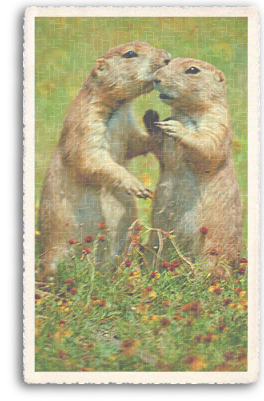 Prairie Dogs have an intricate highly-social system composed of one male and several close-kin females and their offspring. Populations vary from 5 to 35 per acre. Prairie Dogs live three to five years in the wild and have lived up to 8.5 years in captivity. Prairie Dogs have an intricate highly-social system composed of one male and several close-kin females and their offspring. Populations vary from 5 to 35 per acre. Prairie Dogs live three to five years in the wild and have lived up to 8.5 years in captivity.The Prairie Dog digs its own burrows. There is a well-constructed and frequently reinforced dike against flooding from sudden rains. The entrance holes themselves are funnel-shaped, from three to four inches in diameter. These tunnels lead down a steeply slanting corridor 15 or 16 feet before leveling off for another 20 to 50 feet. There are side chambers for storage, for nesting and for escape should the tunnel be invaded by predators or flooding. They may extend 100 feet or more. The Prairie Dogs trim the vegetation around their colonies, perhaps to remove any cover for predators. When a predator approaches, the first alert the Prairie Dog gives is a sharp warning call. They then bob up and down in excitement, call again and then plunge into the burrow below. The danger signal is a two-syllable bark, issued at about 40 per minute. Other sentinels farther from the danger zone take up the watch, monitoring the course of the predator. Although Prairie Dogs are almost exclusively vegetarian, nursing females have been observed both cannibalizing and communally nursing each other’s pups. The various native plants of the Great Plains make up the Prairie Dog’s primary diet, comprising all kinds of grasses, roots, weeds, forbs and blossoms. They acquire all of their water from the food they eat. Sometimes insects are also eaten. One litter is born to the Prairie Dog female each year. During a four- or five-hour estrus, a female Prairie Dog may mate with as many as five different males, allowing pups from the same litter to have different fathers. For the Black-tailed Prairie Dog, mating generally occurs in late January, with the young being born in March and April (a gestation period of 28 to 32 days). The White-tailed Prairie Dog mates in March or April, with the young being born in May. These youngsters hibernate with their parents October through March in the north and in high mountain valleys. There are usually three to five youngsters in a litter, but sometimes as many as eight. The young are blind and hairless. Their eyes don’t open for 33 to 37 days. At about six weeks old, they begin to appear above ground and are ready to be weaned. They probably separate from the mother by early fall. During May and the early part of June, the young begin to emerge from their burrows for the first time. Also at this time, yearlings (young from the previous year) and some adults may relocate, leaving the young pups to feel secure both socially and environmentally in the old burrow. When Prairie Dogs relocate, they take over abandoned holes or dig new holes at the edge of the town. A few may travel miles in search of new areas, but once away form the communal warning system, most are easy prey for predators. Because they eat as much as seven percent of a ranch’s forage, Prairie Dog eradication programs have been underway for decades in the American West. This program of extermination probably originated in the nineteenth century, hundreds of years after the Native Americans began using prairie dogs as a food source. But a growing number of experts argue that Prairie Dogs may actually be beneficial, that they are natural fertilizers who also increase the protein content and digestibility of rangeland grasses. Ecologists consider this rodent to be a keystone species. They are an important prey species, being the primary diet in prairie species such as the black-footed ferret, the swift fox, the golden eagle, the badger, and the ferruginous hawk. Other species, such as the mountain plover and the burrowing owl also rely on prairie dog burrows for nesting areas. Even grazing species, such as bison, pronghorn and mule deer have shown a proclivity for grazing on the same land used by prairie dogs. It is believed that they prefer the vegetative conditions after prairie dogs have foraged through the area. 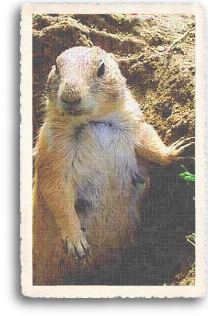 At the beginning of the 20th century, as many as five billion Prairie Dogs occupied millions of acres of grass prairies across the West. In fact, in 1900, a huge Prairie Dog settlement was reported on the high plains of Texas. It extended 100 miles in one direction and 250 miles in the other. An estimated 400 million Prairie Dogs lived in this “town.” Today, after decades of eradication by federal, state, and local governments, and devastation from disease, poisoning, recreational shooting and habitat destruction, Prairie Dogs are rapidly disappearing. More have been exterminated than remain, inhabiting only about two percent of their former range. Colonies are being preserved, however, in Wind Cave National Park, Devils Tower National Monument, and in the Wichita Mountains Wildlife Reserve. The city of Santa Fe maintains a municipal park with a resident colony of Gunnison's Prairie Dogs, and the Prairie Dog village at the Jackalope import store compound is also a popular spot to watch these creatures in a natural-style habitat. Prairie Dog habitat has been impacted by encroachment of human development, and removal by ranchers and farmers. The numbers of all species of Prairie Dogs have been greatly reduced as a result. The largest remaining community is comprised of Black-tailed Prairie Dogs. In spite of this, Prairie dog towns have adapted to development, forming in open lots of urban areas near human housing and construction in southwestern cities like Denver, Santa Fe, Taos, and Salt Lake City. Black-tailed Prairie Dogs are frequently exterminated from ranchland, being labeled as a pest. Their habitat has been fragmented, and their numbers have been greatly reduced. Studies in 1961 estimated only 364,000 acres of occupied Black-tailed Prairie Dog habitat in the United States. A second study in 2000, showed 676,000 acres. However, a comprehensive study between 10 states and various tribes in 2004, estimated 1,842,000 acres in the United States, plus an additional 51,589 acres in Mexico and Canada. Based on the 2004 studies, the US Fish and Wildlife Service removed the Black-tailed Prairie Dog from the Endangered Species Act Candidate Species List in August 2004. 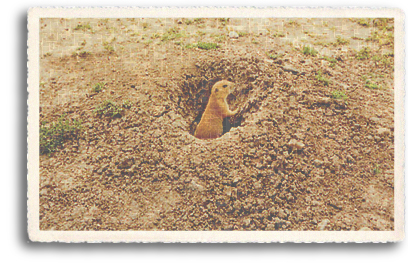 The Prairie Dog in Captivity The Prairie Dog in CaptivityUntil 2003, primarily Black-tailed Prairie Dogs were collected from the wild for the exotic pet trade in Canada, the United States, Japan, and Europe. They were removed from their underground burrows each spring, as young pups, with a large vacuum device. They are difficult to breed in captivity, but it has been done on several occasions. Removing them from the wild was a far more common method of supplying the market demand. They can be difficult pets to care for, requiring regular attention, and a very specific diet of grasses and hay. Each year they go into a period called rut, that can last for several months, in which their personalities can drastically change, often becoming defensive or even aggressive. Despite these special needs, Prairie Dogs are very social animals and almost seem to treat humans as members of their colony, answering barks and chirps, and even coming when called by name. In mid-2003, due to cross-contamination at a pet swap from an unquarantined Gambian pouched rat imported from Ghana, several Prairie Dogs in captivity acquired monkey pox, and subsequently a few humans were also infected. This led the Center of Disease Control to institute an outright ban on the sale, trade, and transport of Prairie Dogs within the United States. The disease was never introduced to any wild populations. In response, the European Union also banned importation of Prairie Dogs. While this is seen as unfair by many exotic pet owners and vendors, the monkey pox scare was not the only zoonosis incident associated with Prairie Dogs; these rodents are also very susceptible to bubonic plague, and several wild colonies have been wiped out by the disease. Also, in 2002, a large group of Prairie Dogs that were in captivity in Texas were found to have contracted tularemia. Prairie Dogs are not natural carriers of any of the three mentioned diseases, but the ban is believed to be in the best interests of protecting the public and there are no intentions of ever lifting it. Prairie Dogs that were in captivity at the time of the ban in 2003, are allowed to be kept under a grandfather clause, but they may not be bought, traded, or sold and transport is only permitted to and from a veterinarian under proper quarantine procedures. Prairie Dog Organizations Prairie Dog Coalition PrairieDogs.org Back to Plants & Wildlife |
||
Home | Food | Lodging | Merchants | Services | Real Estate | Art & Galleries | Entertainment | Recreation Ski Areas | Mind-Body-Spirit | Taos Information | Local Color | Taos Pueblo | High Road to Taos | Taos Plaza | Ranchos de Taos Scenic Beauty | Day Trips | Chili | Special Events | Taos History | Multicultures | Museums | The Enchanted Circle The Wild West | Taos Art Colony | Plants & Wildlife | Counterculture | Turquoise | Architecture | Features | About Us | Get Listed! Taos Unlimited Trading Post | Photo of the Week | Link of the Month | Taos Webcams | Taos Weather | Testimonials | Guestbook Taos A to Z | Movie Locations | Sitemap | Taos Unlimited Blog | Aimee & Jean's Story Blog | Contact Us | Santa Fe Unlimited |
||